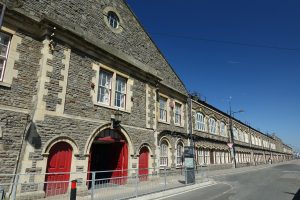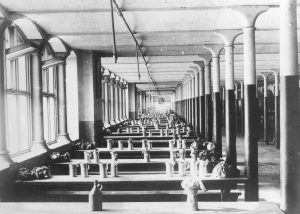Filmmaker and Swindon resident Martin Parry outlines an alternative to the proposed £22m Museum and Art Gallery Project.
"As an art lover I would like to see a more spacious art gallery. The problem with the new gallery proposal is that it misses an even better opportunity. One far more audacious."
“By ignoring its most important history, Swindon will not just neglect its proud past but undermine its future - through missing the massive power this strong heritage has to advance the town's reputation and development.”

The former GWH carriage works
Martin believes the key to the town's regeneration lies in its potential as the centre of a future Great Western Railway World Heritage Site - as recently proposed by English Heritage. This envisions a World Heritage area comprising a 'necklace' of pearls strung from Paddington to Bristol - with Swindon’s historic railway quarter acting as the pendant bang in the middle.
“This would see Swindon becoming truly appreciated for its achievements as well as a major visitor attraction.
“The case for world heritage status for the GWR line is strong. It is after all the most complete early main line railway in the world, designed and constructed by the world class engineer Isambard Brunel. It is true that UNESCO have not yet accepted the initial proposal, and although they do not usually give reasons, research shows that is likely due to the recent poor state of repair of a number of Railtrack heritage assets along the line; coupled with Swindon's apparent neglect of the central portion comprising the Mechanics’ Institution and Railway Village conservation area. But Railtrack have since done much to improve their heritage assets, and I feel it's now time for Swindon to step up and play its part.”

A view inside the carriage works canteen 1875
Martin said: “Swindon’s first heritage funding initiative needs to be centred on the Mechanics', it is not only ready to go (after extensive preparation by The Mechanics' Institute Trust over recent years) but is in accord with local people’s wishes.
“Every relevant public meeting, including the recent one by Swindon Heritage Board, has shown that the priority for the people of Swindon in terms of heritage is the restoration of The Mechanic's Institution.
“The Mechanics' is the priority building because it represents all the keynote 'firsts' in our history that stand head and shoulders above everything else we have achieved – here was Britain's first lending library, the forerunner of the nation's Technical Colleges, first arts centre and birthplace of the NHS.
“The source of these, The Mechanics’ Institution, vitally needs restoration in order to kick-start and take its proper place at the centre of a new World Heritage Site.

The Salts Mill gallery in Saltaire, Yorkshire
“It should be refurbished in the way advocated by the Mechanics' Trust for some years now, as an assembly-based cultural centre with theatre, restaurants, forum and conference spaces in keeping with its original function.”
“Many people are saying 'We can have both the Mechanics and a Gallery' but this will only be possible if we approach things in the right order. The first step being a Heritage Lottery Fund application to jointly restore the Mechanics’ and the adjoining Carriage Works as a coupled initiative so that they can serve mutually co-ordinated purposes.”
Martin believes the already identified £7m of public money plus the regeneration funding should mainly go to refurbishing the Carriage Works to serve three main functions. A Museum of Swindon on the lower London Street level in the original Victorian canteen. For the vast upper level adjoining the main line he proposes a world class art gallery for the eastern half, and for the western half, a new national Museum of Engineering.
“Where better than Swindon for this first? With our own achievements in the field, from the GWR through Garrards to Honda we are ideally placed to work together with the National Science Museum at Wroughton and pull off this coup.
“Together with the Mechanics' Institution and 'Steam' this initiative should enable us to gain World Heritage status for the line and bring in visitors galore. The position of the Carriage Works along the mainline will, with appropriate signage, striking sculpture and modern lighting effects triggered by passing trains, publicise the offer endlessly to everyone who passes on their way to Wales or the West Country - and with little ongoing cost.
“Some of the attractions and special exhibitions could be chargeable to outside visitors and bring in valuable revenue as well as feed visitors into the Brunel Centre shopping precinct or on to 'Steam'.
“All around the country (and as close to us as Gloucester and Bristol) similar industrial heritage buildings are making striking new galleries that work immensely well - David Hockney, for example, has chosen a gallery in a converted Victorian mill in Saltaire as the site of his permanent exhibition.
And the most visited art gallery in the world, Tate Modern, is in a re-purposed industrial building. We only need look at the tremendously successful conversion of our own outlet village to see how appealing the 'Carriage Works' will be as a public space, and how much character is added by Victorian architectural features.
“Building on the success of this initiative, if people still found they wanted a new-build gallery, there would be nothing to stop us going for it in a few years’ time. And it would have a better chance of success if based on the reputation and earnings already achieved as part of a World Heritage attraction.
“But as a National Museum of Engineering develops its potential I suspect we will become fond of having a world class art gallery attached to it; and both centred in what is after all our real cultural quarter as well as somewhere the world can see it.”
Martin operates Western Film Archive, which was established in 1987 with David Puttnam as its Honorary President, and has since collected almost 3,000 film and video items covering a wide range of local subjects stretching back over a hundred years. Many of these are unique and have needed painstaking restoration and digitisation to make them available to schools and the public. Most are available for viewing on www.swindonviewpoint.com
Martin lives in Eastcott where he has raised three children. Besides his major films on Swindon, he has made many short films on the local arts scene as well as a considerable number of music programmes.






Your Comments
Be the first to comment on this article
Login or Register to post a comment on this article